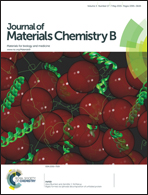Synergistic mediation of tumor signaling pathways in hepatocellular carcinoma therapy via dual-drug-loaded pH-responsive electrospun fibrous scaffolds
Abstract
With the understanding of tumorigenesis, the tumor-infiltrating inflammatory cells, which could contribute to carcinogenesis, have greatly drawn public attention. We hypothesized that controlling inflammation in the initial stage along with antitumor activity for a relatively long term could prevent tumor recurrence. Herein, we designed a novel electrospun composite poly(L-lactide) (PLLA) fibrous scaffold, which contained sodium bicarbonate (SB) and doxorubicin (DOX) inside mesoporous silica particles (MSNs) to achieve long-term pH-sensitive DOX release and ibuprofen (IBU) outside MSNs to achieve initial short-term release. This construct was found to exhibit an initial burst release of IBU at an early stage and sustained the release of DOX at a relatively later stage. In vivo results showed that when the fibrous scaffold was implanted in a liver-tumor-bearing nude mouse, the mouse lifespan was prolonged to 1.5 times higher than that when implanted with scaffolds with no IBU or SB. Moreover, the residual tumor treated with PLLA–(MSN/DOX–SB)–IBU fibers demonstrated considerable signs of apoptosis and large areas of necrosis over a 10 week examination period. By combining the in vitro and in vivo experiments, the results have suggested that this dual drug delivery system could effectively inhibit inflammation in the initial stage and prevent tumor recurrence for a relatively long term, and it may find application as a local implantable scaffold to treat a tissue defect after tumor resection.


 Please wait while we load your content...
Please wait while we load your content...